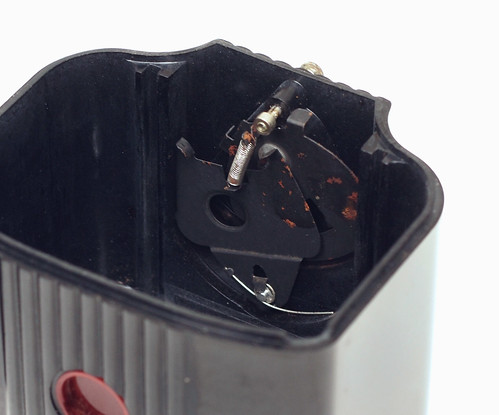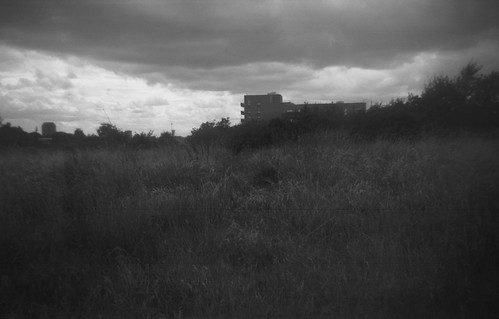 |
| Kodak Baby Brownie |
The emergence of plastic in the manufacture of cameras from the late 1920s into the 1930s allowed for the typical shape of the snapshot camera to radically change. The Kodak Baby Brownie with its Bakelite body, updates the simple, entry-level box camera. One imagines that it looked very modern when first produced, in comparison to Kodak's typical box camera, which only recently would have been made with a cardboard body. The Kodak Baby Brownie owes its distinctive styling to Walter Dorwin Teague who designed many cameras for Kodak: the
vertical ribbed designs that run around the camera with the central roundel of the lens makes it a little reminiscent of an
Art Deco radio set, while the curves and scalloped edges evoke light wooden furniture, a bureau or a cabinet perhaps. It was not Kodak's first plastic camera–according to Art Deco Cameras, Kodak Ltd in the UK had that honour with the No. 2 Hawkette–the Hawkette however was made for promotional purposes, not for general retail; according to numerous sources, 4 million Kodak Baby Brownies were produced over the two phases of its production either side of the Second World War.
It appears that the rationale behind the design of the Kodak Baby Brownie was Kodak's desire to return to the $1 price point of the original Brownie camera of 1900 (it's worth mentioning that this does not of course account for the effect of inflation over the thirty-odd years–a single dollar must have bought a lot more in 1900 compared to 1934, when the Baby Brownie appeared; the low price of the camera presumably reflects the economies of scale possible with Kodak's manufacturing in the mid-thirties). The Kodak Baby Brownie is simpler than the original Brownie too, partly due to the plastic construction. The meniscus lens is fixed-focus, with a fixed-aperture, and the rotary shutter has a single speed. Most sites profiling the camera do not usually provide lens and
shutter specifications: Art Deco Cameras lists the lens' focal length as being 60mm, its aperture as f16 and the shutter speed at 1/50th; the manual states that "everything about five feet and beyond will be photographed sharply". It takes 127 format rollfilm, smaller and cheaper than 120, appropriately for a cheap camera appearing during the Depression, although it does use the 'full-frame' of the 127 format, nominally 4x6cm, giving eight exposures on a roll of 127 film–other cameras had already created the 'half-frame' 3x4cm negative size, which provides sixteen frames on a roll.
The Kodak Baby Brownie had two distinct periods of production. Kodak manufactured the Baby Brownie in the US until 1941; subsequently, Kodak Ltd in the UK made the camera between 1948-52. Given that there appears to be no observable differences between the US and UK made Baby Brownies, one wonders whether the dies and moulds were shipped out to the UK after the Second World War to boost the Kodak Ltd's postwar production, with the Baby Brownie, coming of the Depression, now a fitting camera for Austerity Britain, still in rationing. There was a slight variant model Kodak Baby Brownie for export, distinguished by a metal stud or pin above the lens. This is a 'time' setting: pull the stud out, and the shutter stays open when the shutter lever is pressed. The Brownie Camera Page states that this export version was made in the UK during the camera's second production run; my camera has the time setting, although the lettering on the bottom of the camera clearly reads "MADE IN USA". If exactly the same moulds were used for the UK-made camera (the time setting requiring a single small hole to be drilled through the front), this might explain this discrepancy, although I would have thought that any camera made in the UK would have to be marked as such. As well as the 'export variant' there was also a commemorative version made for the 1939 New York's World Fair, which has a rectangular name plate around the lens with this lettering: the camera itself has 'BABY BROWNIE' embossed around the lens.
 |
| Kodak Baby Brownie with viewfinder raised |
I bought my Kodak Baby Brownie at the Place du Jeu de Balle flea market
in Brussels in late spring last year for €10, haggled down from €15
(there were many other cameras there, but I was on a tight budget after a
week abroad, and knowing that there's usually very little that can go
wrong with a simple box camera, the Brownie seemed a safe investment). I
used it last year on the 127 Day in July, but did not scan the
negatives at the time, a couple of which illustrate this post below.
When I bought the camera I wasn't aware of the export variant, but was
pleased that was what I had, a small difference which does increase the
conditions in which the camera can be used–although with some caveats,
mentioned below. The modest size of the camera, with its curved and ribbed shape, as well as the Bakelite itself, does feel good in the hand, perhaps rather like an over-sized netsuke.
To open the camera for loading and unloading film, on the camera's base is a metal lever which pivots between OPEN/CLOSE (and sweeps over lettering stating the camera was made in the USA). The top slides out from the body with the film carrier attached. Opening the camera shows how simply it is constructed despite its Art Deco stylings: the camera is made from three pieces of Bakelite, the body, top plate, and film carrier, with a few metal fixings.
 |
| Kodak Baby Brownie - opened for loading |
The the camera has a curved film plane, a common strategy to compensate for the limitations of a simple meniscus lens. The inside moulding is ribbed behind the lens inside counter reflections on the smooth Bakelite surface. One can also see that there's a metal stop behind the lens to reduce its aperture and increase definition, another frequent compensation for the limitations of a simple lens. The film spools are held either side of the lens opening on the film carrier by a sprung metal clip, with an additional piece of sprung curved metal on the supple-side to prevent the film from unspooling. Manual frame advance uses the red window in the middle of the camera back.
 |
| Kodak Baby Brownie - opened for loading |
The rotary shutter on my camera has some rust as can be seen in the image below. To trip the shutter, the lever has to be pulled to the left from the user's position; it springs back into position with a self-capping function. The time setting works by simply blocking the shutter from completing its swing when the pin or stud is pulled out. The shutter lever needs constant pressure for the shutter to remain open: it will close when the shutter lever is released, or if the time pin is pushed back in. Framing is achieved by a fold-up open frame finder on the top of the camera body.
 |
| Kodak Baby Brownie - detail of shutter mechanism |
My camera had some damage to two opposite corners, showing the fragility of the Bakelite: the chip on the inside rear corner I thought might possibly cause a light leak, which can be seen in the image above. To counter this, I added a small strip of black tape on the inside of the body. Using the camera for July 2023's 127 Day, the few frames from the Kodak Baby Brownie show that the lens has fairly good
definition in the centre of the image, but this does fall off
considerably towards the edges. When the camera was produced, most photographs for the typical user would probably have been made as contact prints and the limitations of the lens less apparent.
 |
| Kodak Baby Brownie with Fomapan 200 |
I used Fomapan 200 for the images on this post. Despite the photographs being taken in July, the weather was heavily overcast on the day, and a 400 speed film (or pushing a stop in development) would have been a better choice. The manual states for best results "outdoor exposures should be made with the subjects in bright sunlight", the usual conditions for a typical box camera when these were made; using a faster emulsion allows for a broader range of subject conditions for these cameras than would have been the case when first in use.
 |
| Kodak Baby Brownie with Fomapan 200 |
The one aspect of the Kodak Baby Brownie in use that feels to me not sufficiently thought-through is the position of the shutter lever: placed directly below the lens, this keeps the camera's design symmetrical, with the exception of the winding knob. Here, it feels as though it should naturally be used by the left hand (an illustration in the manual confirms this), and the action of tripping the shutter is to pull it away from the camera's centre of gravity (which must increase the chance of some camera shake). There was a successor to the Kodak Baby Brownie, also designed by Walter Dorwin Teague, though rather less beautiful, in the Kodak Baby Brownie Special. It is notable that the shutter button of the Special is on the user's right, and it pushes in to trip the shutter. The position of the shutter lever on the Kodak Baby Brownie being directly under the lens is also inconvenient when using the time function: the camera does not have a tripod fixing, but the camera's based is fairly flush, allowing for it to be placed on a level surface for long exposures–which makes reaching for the shutter lever less easy–almost any other placement on the camera would be better for this. However, this additional function of the export variant of the Baby Brownie, must make it a little more desirable over the standard model.
Sources/further reading
The Kodak Baby Brownie on Camera-wiki
Baby Brownie on The Brownie Camera Page
On Art Deco Cameras with manual (PDF)
Kodak Baby Brownie on Retro Film Camera
Kodak Baby Brownie on Down the Road
A Camera Worth a Thousand Words Cooper Hewitt
No comments:
Post a Comment